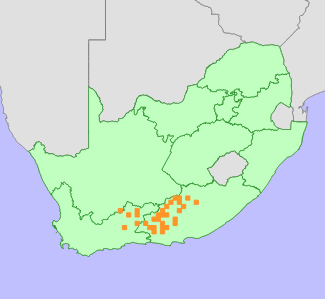|
Scientific Name | Monsonia camdeboensis (Moffett) F.Albers |
Higher Classification | Dicotyledons |
Family | GERANIACEAE |
Synonyms | Sarcocaulon camdeboense Moffett |
Common Names | Karoo Bushman Candle (e), Kersbos (a) |
National Status |
Status and Criteria | Least Concern |
Assessment Date | 2019/11/10 |
Assessor(s) | L. von Staden |
Justification | Monsonia camdeboensis is a widespread species that is not in danger of extinction. It has an extent of occurrence (EOO) of 60 348 km², and is recorded from more than 40 subpopulations. It is therefore listed as Least Concern. |
Distribution |
Endemism | South African endemic |
Provincial distribution | Eastern Cape, Northern Cape, Western Cape |
Range | This species is endemic to South Africa, and is found in the Great Karoo between Beaufort West, Sterkstroom and Willowmore. |
Habitat and Ecology |
Major system | Terrestrial |
Major habitats | Steytlerville Karoo, Eastern Upper Karoo, Upper Karoo Hardeveld, Eastern Lower Karoo, Gamka Karoo, Tarkastad Montane Shrubland, Karoo Escarpment Grassland, Southern Karoo Riviere, Sundays Arid Thicket, Fish Valley Thicket, Escarpment Valley Thicket, Escarpment Arid Thicket |
Description | It occupies rocky dolerite ridges, or rocky outcrops on shale plains. |
Threats |
| While Monsonia camdeboensis is experiencing ongoing decline in habitat quality as a result of livestock overgrazing and drought, its life history of being a spiny stem succulent protects it from the impacts of both these pressures. It has been recorded widely in recent surveys of the Karoo indicating that it can persist despite livestock grazing.
In addition, while much of this species' range falls within an area earmarked for shale gas fracking, a Strategic Environmental Impact Assessment submitted to South Africa's Department of Environmental Affairs in 2016 cautioned against moving ahead with Shale Gas fracking based on the very high infrastructure costs associated with fracking as well as multiple secondary negative impacts both to biodiversity and other economic activities in the region. Furthermore geological studies that have taken place since 2016 have found that gas deposits are not as substantial as originally suspected due to the very old age of the Karoo shale formations and the dolerite intrusions that occur throughout the Karoo having resulted in much of the gas being lost. At present, future development scenarios are too uncertain to estimate the potential extent of the impact on the population but it is unlikely that shale gas fracking will proceed in the near future. |
Population |
This species occurs as scattered individuals across the shale plains of the Karoo. It was regularly encountered during the Karoo BioGaps project that surveyed the Karoo plains between 2016 and 2018. In addition, there are many recent records of this species posted on iNaturalist.
|
Population trend | Stable |
Assessment History |
Taxon assessed |
Status and Criteria |
Citation/Red List version | | Monsonia camdeboensis (Moffett) F.Albers | Least Concern | 2015.1 | | Sarcocaulon camdeboense Moffett | Least Concern | Raimondo et al. (2009) | |
Bibliography |
Albers, F. 1996. The taxonomic status of Sarcocaulon (Geraniaceae). South African Journal of Botany 62(6):345-347.
Moffett, R.O. 1979. The genus Sarcocaulon. Bothalia 12(4):581-613.
Raimondo, D., von Staden, L., Foden, W., Victor, J.E., Helme, N.A., Turner, R.C., Kamundi, D.A. and Manyama, P.A. 2009. Red List of South African Plants. Strelitzia 25. South African National Biodiversity Institute, Pretoria.
Snijman, D.A. 2013. Plants of the Greater Cape Floristic Region 2: The extra Cape flora. Strelitzia 30. South African National Biodiversity Institute, Pretoria.
|
Citation |
| von Staden, L. 2019. Monsonia camdeboensis (Moffett) F.Albers. National Assessment: Red List of South African Plants version 2024.1. Accessed on 2025/12/02 |
 Comment on this assessment
Comment on this assessment

